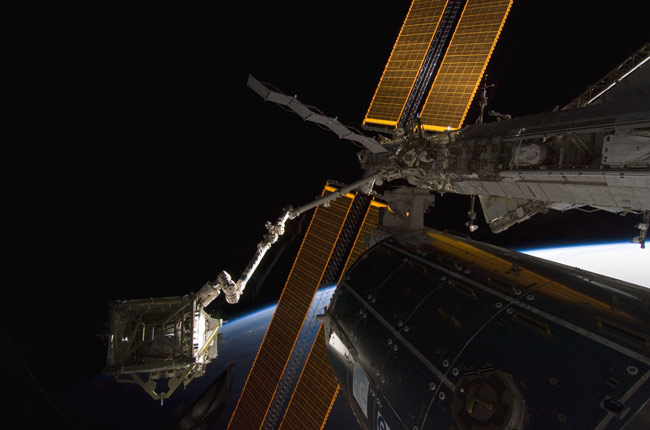Spacewalkers Successfully Attach Station's Solar Wings

Thisstory was update at 8:17 p.m. EDT.
Twospacewalking astronauts floated outside the International Space StationThursday to help attach the last pair of solar wings for the orbital lab?spower grid.
Clad intheir NASA-issue spacesuits, astronauts Steven Swanson and Richard Arnold IIspent just over six hours installing the new solar arrays and their 16-tonsupport girder on the space station?s starboard side.
?It?s a lotbigger than when you left it, you guys were outstanding,? stationcommander Michael Fincke told the spacewalkers as they began wrapped uptheir work. ?Thanks for the hard work.?
Deliveredby the shuttle Discovery, the $298 million solar wings are due to be unfurledon Friday. Until then, they?ll stay folded up like oversized maps inside theirstorage boxes.
The stationcurrently has six solar wings, two for each of its three deployed arrays. Whenthe new arrays are deployed, the station will have eight wings, with four oneach side giving it a symmetrical look.
Astronautsinside the space station used the orbiting lab?s robotic arm to gently ease thesolar wing segment in place, making tiny adjustments based on verbal cues fromSwanson and Arnold, who had a ringside seat to the delicate attachment.
Get the Space.com Newsletter
Breaking space news, the latest updates on rocket launches, skywatching events and more!
Thespacewalkers secured the 45-foot (14-meter) solar array girder in place withfour bolts and hooked up a power and data cables, at times wrestling withstubborn clasps.
?It wasn'tquite as smooth as we had hoped, but those guys did a great job,? saidDiscovery astronaut Joseph Acaba, who choreographed the spacewalk from theshuttle and - like Arnold - is a former schoolteacher.
Thursdayspacewalk began at 1:16 p.m. EDT (1716 GMT) as the docked shuttle and spacestation flew 220 miles (354 km) above the Pacific Ocean near New Guinea. WhileSwanson and Arnold worked outside, their crewmates inside the stationsuccessfully repaired Discovery?s broken exercise bike.
?It was agreat team effort out there today,? Swanson said. ?Wonderful.?
Spacestation power up
Each of thespacestation?s new solar wings will extend about 115 feet (35 meters) whendeployed and, together, will boost the outpost?s power grid by 25 percent. Whencomplete, the four U.S. solar arrays will generate enough electricity to power42 average sized homes, NASA has said.
That poweris vital for the space station, where astronauts hope to increase the amount ofscience performed inside its U.S., Russian, European and Japanese modules. Theextra power will also be needed once the space station doubles its crew size upto six people in late May.
The newstarboard solar wings are moored to a 31,000-pound (14,061-kg) girder known asthe Starboard-6 (S6) truss. It is the lastmajor American-built piece of the $100 billion International Space Stationand the final part of the outpost?s 11-segment main truss.
With the S6girder?s installation, the space station now weighs nearly 1 million pounds(453,592 kg), with its backbone-like main truss extending more than 300 feet(91 meters), long than a football field. The space station can be easilyspotted from Earth by the naked eye on a clear night.
Thursday?sspacewalk marked the 121st excursion dedicated to space station constructionand the first of three planned for Discovery?s astronauts.
It was thethird career spacewalk for Swanson, who finished with 19 hours and 52 minutes,and the first for Arnold, who is making his first spaceflight.
Discovery?smission initially included four spacewalks and one extra day. NASA shortenedthe flight after a series of launch delays so the shuttle crew could completethe construction work and leave the station before the arrival of a previouslyscheduled Russian Soyuz spacecraft.
That Soyuzis due to launch a new crew and Americanbillionaire Charles Simonyi, who is paying about $35 million for his secondspace tourist flight, to the station next week.
SPACE.comis providing continuous coverage of STS-119 with reporter Clara Moskowitz andsenior editor Tariq Malik in New York. Click here for missionupdates and SPACE.com's live NASA TV video feed.
- New Video - Discovery?s STS-119 Night Launch
- Video - Discovery's Mission: Space Station Power Up!
- New Show - Inside the International Space Station
Join our Space Forums to keep talking space on the latest missions, night sky and more! And if you have a news tip, correction or comment, let us know at: community@space.com.

Tariq is the Editor-in-Chief of Space.com and joined the team in 2001, first as an intern and staff writer, and later as an editor. He covers human spaceflight, exploration and space science, as well as skywatching and entertainment. He became Space.com's Managing Editor in 2009 and Editor-in-Chief in 2019. Before joining Space.com, Tariq was a staff reporter for The Los Angeles Times covering education and city beats in La Habra, Fullerton and Huntington Beach. In October 2022, Tariq received the Harry Kolcum Award for excellence in space reporting from the National Space Club Florida Committee. He is also an Eagle Scout (yes, he has the Space Exploration merit badge) and went to Space Camp four times as a kid and a fifth time as an adult. He has journalism degrees from the University of Southern California and New York University. You can find Tariq at Space.com and as the co-host to the This Week In Space podcast with space historian Rod Pyle on the TWiT network. To see his latest project, you can follow Tariq on Twitter @tariqjmalik.









